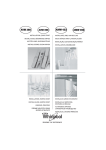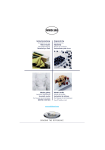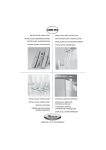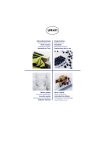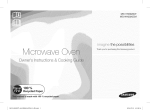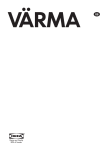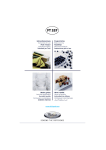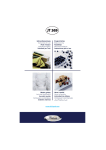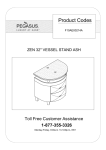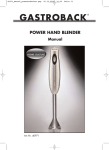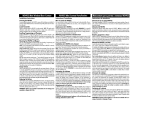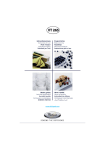Download IFU MWD 202 302 GB 4619-652-74502.indd
Transcript
MWD 202 MWD 302 www.whirlpool.com INSTALLATION DO NOT OPERATE THIS APPLIANCE if it has a damaged mains cord or plug, if it is not working properly, or if it has been damaged or dropped. Do not immerse the mains cord or plug in water. Keep the cord away from hot surfaces. Electrical shock, fire or other hazards may result. PRIOR TO CONNECTING CHECK THAT THE VOLTAGE on the rating plate corresponds to the voltage in your home. PLACE THE OVEN ON A STABLE, EVEN SURthat is strong enough to hold the oven and the food utensils you put in it. Use care when handling. FACE DO NOT USE EXTENSION CORD: POSITION THE OVEN AT A DISTANCE from other heating sources. For sufficient ventilation there must be a space of at least 30 cm above the oven. The appliance must be placed against a wall, ensure that the space underneath, above and both sides of the oven is empty to allow for proper airflow. The microwave oven shall not be placed in a cabinet. IF THE POWER SUPPLY CORD IS TOO SHORT, have a qualified electrician or serviceman install an outlet near the appliance. WARNING: Improper use of the grounding plug can result in a risk of electric shock. Consult a qualified electrician or serviceman if the grounding instructions are not completely understood, or if doubt exists as to whether the microwave oven is properly grounded. ENSURE THAT THE APPLIANCE IS NOT DAMAGED. Check that the oven door closes firmly against the door support and that the internal door seal is not damaged. Empty the oven and clean the interior with a soft, damp cloth. AFTER CONNECTING THE OVEN CAN BE OPERATED ONLY if the oven door is firmly closed. POOR TELEVISION RECEPTION and radio interference may result if the oven is located close to a TV, radio or aerial. THE EARTHING OF THIS APPLIANCE is compulsory. The manufacturer will accept no responsibility for injury to persons, animals or damage to objects arising from the non-observance of this requirement. The manufacturers are not liable for any problems caused by the user’s failure to observe these instructions. 2 GB IMPORTANT SAFETY INSTRUCTIONS READ CAREFULLY AND KEEP FOR FUTURE REFERENCE DO NOT HEAT, OR USE FLAMMABLE MATERIALS in or near the oven. Fumes can create a fire hazard or explosion. ONLY ALLOW CHILDREN to use the appliance without adult supervision after adequate instructions have been given, so that the child is able to use the appliance in a safe way and understands the hazards of improper use. Children should be supervised when using other heatsources (if available) separately or in combination with microwaves due to the high temperatures generated. THIS APPLIANCE IS NOT INTENDED FOR use by persons (including children) with reduced physical, sensory or mental capabilities, or lack of experience and knowledge, unless they have been given supervision or instruction concerning use of the appliance by a person responsible for their safety. CHILDREN SHOULD BE SUPERVISED to ensure that they do not play with the appliance. DO NOT USE YOUR MICROWAVE oven for drying textiles, paper, spices, herbs, wood, flowers, fruit or other combustible materials. Fire could result. IF MATERIAL INSIDE / OUTSIDE THE OVEN SHOULD keep oven door closed and turn the oven off. Disconnect the power cord or shut off power at the fuse or circuit breaker panel. IGNITE OR SMOKE IS OBSERVED, DO NOT OVER-COOK FOOD. Fire could result. DO NOT LEAVE THE OVEN UNATTENDED, especially when using paper, plastic or other combustible materials in the cooking process. Paper can char or burn and some plastics can melt if used when heating foods. Do not leave the oven unattended if you are using a lot of fat or oil since they can overheat and cause a fire! DO NOT USE YOUR MICROWAVE oven for heating anything in airtight sealed containers. The pressure increases and may cause damage when opening or may explode. DO NOT USE corrosive chemicals or vapors in this appliance. This type of oven is specifically designed to heat or cook food. It is not designed for industrial or laboratory use. THE DOOR SEALS AND THE DOOR SEAL AREAS must be regularly inspected for damage. If these areas are damaged the appliance should not be operated until it has been repaired by a trained service technician. DO NOT HANG OR PLACE heavy items on the door as this can damage the oven opening and hinges. The door handle should not be used for hanging things on. THE APPLIANCES ARE NOT INTENDED to be operated by means of an external timer or separate remote-control system. EGGS DO NOT USE YOUR MICROWAVE oven for cooking or reheating whole eggs with or without shell since they may explode even after microwave heating has ended. GB 3 PRECAUTIONS GENERAL LIQUIDS E.G. BEVERAGES OR WATER. Overheating the liquid beyond boiling point can occur without evidence of bubbling. This could result in a sudden boil over of the hot liquid. To prevent this possibility the following steps should be taken: 1. Avoid using straight-sided containers with narrow necks. 2. Stir the liquid before placing the container in the oven and let the teaspoon remain in the container. 3. After heating, allow standing for a short time, stirring again before carefully removing the container from the oven. THIS APPLIANCE IS DESIGNED FOR DOMESTIC USE ONLY! THE APPLIANCE SHOULD NOT BE OPERATED without food in the oven when using microwaves. Operation in this manner is likely to damage the appliance. THE VENTILATION OPENINGS on the oven must not be covered. Blocking the air intake or exhaust vents may cause damage to the oven and poor cooking results. IF YOU PRACTICE OPERATING the oven, put a glass of water inside. The water will absorb the microwave energy and the oven will not be damaged. DO NOT STORE or use this appliance outdoors. DO NOT USE this product near a kitchen sink, in a wet basement, or near a swimming pool, or similar. AFTER HEATING BABY FOOD or liquids in a baby bottle or in a baby food jar, always stir and check the temperature before serving. This will ensure that the heat is evenly distributed and the risk of scalding or burns can be avoided. Ensure the Lid and the Teat is removed before heating! DO NOT USE THE CAVITY for any storage purposes. REMOVE WIRE TWIST-TIES from paper or plastic bags before placing bag in the oven. DEEP-FRYING DO NOT USE YOUR MICROWAVE oven for deep-frying, because the oil temperature cannot be controlled. USE HOT PADS OR OVEN MITTS to prevent burns, when touching containers, oven parts, and pan after cooking. Accessible parts may become hot during use, young children should be kept away. 4 GB ACCESSORIES GENERAL TURNTABLE SUPPORT USE THE TURNTABLE SUPPORT under the Glass turntable. Never put any other utensils on the turntable support. Fit the turntable support in the oven. THERE ARE a number of accessories available on the market. Before you buy, ensure they are suitable for microwave use. ENSURE THAT THE UTENSILS YOU USE are oven proof and allow microwaves to pass through them before cooking. WHEN YOU PUT FOOD AND ACCESSORIES in the microwave oven, ensure that they do not come in contact with the interior of the oven. This is especially important with accessories made of metal or metal parts. GLASS TURNTABLE USE THE GLASS TURNTABLE with all cooking methods. It collects the dripping juices and food particles that otherwise would stain and soil the interior of the oven. Place the Glass turntable on the turntable support. IF ACCESSORIES CONTAINING METAL comes in contact with the oven interior, while the oven is in operation, sparking can occur and the oven could be damaged. WIRE RACK USE THE WIRE RACK when cooking with Grill functions. ALWAYS ENSURE that the turntable is able to turn freely before starting the oven. If the turntable isn’t able to turn freely you should use a smaller vessel. CHOOSING MICROWAVE POWER POWER SUGGESTED USE: MAX (700 W) REHEATING OF BEVERAGES, water, clear soups, coffee, tea or other food with a high water content. If the food contains egg or cream choose a lower power. 600 W COOKING OF fish, meat, vegetables etc. 400 W MORE CAREFUL COOKING e.g. high protein sauces, cheese and egg dishes and to finish cooking casseroles. Simmering stews, melting butter. DEFROST DEFROSTING. Softening butter, cheeses. KEEP WARM SOFTENING Ice cream. GB 5 PAUSE OR STOP COOKING TO PAUSE COOKING The cooking can be paused to check, turn or stir the food by opening the door. IF YOU DON’T WANT TO CONTINUE COOKING Remove the food, turn the adjust knob to zero and close the door. TO CONTINUE COOKING Close the door. The cooking is resumed from where it was paused. OPERATING THE OVEN 5’ 10’ 25’ 20’ 6 15’ GB q SELECT POWER LEVEL AND FUNCTION by turning the multifunction knob. w TURN THE ADJUST KNOB clockwise to set the desired cooking time. The oven starts automatically. COOKING CHART THE MORE FOOD YOU WANT TO COOK the longer it takes. A rule of thumb is that double amount of food requires almost double the time. THE LOWER STARTING TEMPERATURE, the longer cooking time is required. Food at room temperature cooks faster than food taken directly from the refrigerator. IF YOU ARE COOKING SEVERAL ITEMS of the same food, such as jacket potatoes, place them in a ring pattern for uniform cooking. SOME FOODS ARE COVERED BY A SKIN OR MEMBRANE e.g. potatoes, apples and egg yolks. These food should be pricked with a fork or cocktail stick to relieve the pressure and to prevent bursting. SMALLER PIECES OF FOOD WILL COOK FASTER than larger pieces and uniform pieces of food cook more evenly than irregularly shaped foods. TYPE OF FOOD AMOUNT POWER LEVEL STIRRING AND TURNING OF FOOD ARE techniques used in conventional cooking as well as in microwave cooking to distribute the heat quickly to the center of the dish and avoids overcooking at the outer edges of the food. WHEN COOKING FOOD OF UNEVEN SHAPE or thickness, place the thinner area of food towards the center of the dish, where it will be heated last. FOOD WITH LOT OF FAT AND SUGAR will be cooked faster than food containing a lot of water. Fat and sugar will also reach a higher temperature than water. ALWAYS ALLOW THE FOOD TO STAND for some time after cooking. Standing time always improves the result since the temperature will then be evenly distributed throughout the food. TIME STANDING TIME HINTS TURN THE CHICKEN midway thru cooking. Check that the meatjuice is uncolored when the cooking is finished. CHICKEN (whole) 1000 G 18 - 20 MIN. 5 - 10 MIN. CHICKEN (fillets or pieces) 500 G 8 - 10 MIN. 5 MIN. CHECK that the meatjuice is uncolored when the cooking is finished. BACON 150 G 3 - 4 MIN. 1 - 2 MIN. PLACE ON KITCHEN PAPER, on a plate, in 2 or 3 layers and cover with more kitchen paper. VEGETABLES (fresh) 300 G 3 - 4 MIN. 1 - 2 MIN. VEGETABLES (frozen) 250 400 G 3 - 4 MIN. 5 - 6 MIN. 1 - 2 MIN. JACKET 1 PC 4 PCS 4 - 6 MIN. 12 - 15 MIN. 2 MIN. 5 MIN. MEAT (loaf) 600 700 G 12 - 14 MIN. 5 MIN. FISH (whole) 600 G 8 - 9 MIN. 4 - 5 MIN. FISH (steaks or fillets) 400 G 5 - 6 MIN. 2 - 3 MIN. POTATOES 700 W 600 W GB COOK COVERED and add 2 tbs salt. COOK COVERED PRICK WITH FORK. (1 pc = 250 g). Turn midway thru cooking. SCORE THE SKIN and cook covered. PLACE WITH THINNER PARTS towards the center of the plate. Cook covered. 7 REHEATING CHART AS IN TRADITIONAL COOKING METHODS, food reheated in a microwave oven must always be heated until piping hot. THE BEST RESULTS ARE ACHIEVED if the food is arranged with the thicker food to the outside of the plate and the thinner food in the centre. PLACE THIN SLICES OF MEAT on top of each other or interlace them. Thicker slices such as meat loaf and sausages have to be placed close to each other. TYPE OF FOOD PLATED MEAL RICE MEAT BALLS BEVERAGE SOUP (clear) AMOUNT POWER LEVEL WHEN REHEATING STEWS OR SAUCES it is better to stir once to distribute the heat evenly. COVERING THE FOOD helps to keep the moisture inside the food, reduces spattering and shortens the reheating time. WHEN REHEATING FROZEN FOOD portions follow the manufactures instruction on the package. FOOD WHICH CANNOT BE STIRRED, like gratin is best reheated on 400–600 W. SOME MINUTES STANDING TIME will make sure the temperature is evenly distributed throughout the food. TIME STANDING TIME 300 G 450 G 3 - 5 MIN. 4 - 5 MIN. 1 - 2 MIN. 2 DL 6 DL 1 - 2 MIN. 3 - 4 MIN. 1 MIN. 2 MIN COVER THE DISH 250 G 2 MIN. 1-2 MIN. HEAT UNCOVERED 1 - 2 ½ MIN. 1 MIN. PUT A METAL SPOON in the cup to prevent overcooking. 2½ DL 2 - 2 ½ MIN. 1 MIN. REHEAT UNCOVERED in a soup plate or bowl. 2 ½ DL 2 ½ - 3 MIN. 1 MIN. DO NOT FILL the container more than 3/4. Stir once during heating. ½ - 1 MIN. 1 - 1 ½ MIN. 1 MIN. 5 - 6 MIN. 2 - 3 MIN. 2 DL 700 W MILKBASED SOUPS OR SAUCES HOT DOGS 1 PC 2 PCS LASAGNA 500 G 8 HINTS 600 W GB COVER THE PLATE DEFROSTING CHART TURN LARGE JOINTS halfway through the defrosting process. BOILED FOOD, STEWS AND MEAT SAUCES defrost better if stirred during defrosting time. WHEN DEFROSTING it is better to underthaw the food slightly and allow the process to finish during standing time. STANDING TIME AFTER DEFROSTING always improves the result since the temperature will then be evenly distributed throughout the food. FROZEN FOOD IN PLASTIC BAGS, plastic films or cardboard packages can be placed directly in the oven as long as the package has no metal parts (e.g. metal twist ties). THE SHAPE OF THE PACKAGE alters the defrosting time. Shallow packets defrost more quickly than a deep block. SEPARATE PIECES as they begin to defrost. Individual slices defrost more easily. SHIELD AREAS OF FOOD with small pieces of aluminiumfoil if they start to become warm (e.g. chicken legs and wing tips). TYPE OF FOOD AMOUNT POWER LEVEL TIME STANDING TIME HINTS ROAST 800 1000 G 20 - 22 MIN. 10 - 15 MIN. TURN halfway thru defrosting. MINCED MEAT 500 G 8 - 10 MIN. 5 MIN. TURN halfway thru defrosting. Separate thawed parts. 500 G 7 - 9 MIN. 5 - 10 MIN. TURN halfway thru defrosting. 1200 G 25 MIN. 10 - 15 MIN. TURN halfway thru defrosting. 7 - 9 MIN. 5 - 10 MIN. TURN / SEPARATE halfway thru defrosting. Shield wingtips and legs with foil to prevent overheating. CHOPS, CUTLETS, STEAKS CHICKEN (whole) CHICKEN pieces or fillets 500 G FISH (whole) 600 G 8 - 10 MIN. 5 - 10 MIN. TURN halfway thru defrosting and shield the tail with foil to prevent overheating. FISH (steaks or fillets) 400 G 6 - 7 MIN. 5 MIN. TURN halfway thru defrosting. Separate thawed parts. LOAF OF BREAD 500 G 4 - 6 MIN. 5 MIN. TURN halfway thru defrosting. ROLLS & BUNS 4 PCS (150 - 200 G) 1 ½ - 2 MIN. 2 - 3 MIN. PLACE in a ring pattern. FRUIT & BERRIES 200 G 2 - 3 MIN. 2 - 3 MIN. SEPARATE during defrosting. DEFROST GB 9 GRILLING CHART ENSURE that the utensils you use are heat resistant, ovenproof and allow microwaves to pass through them before Grilling with microwaves combined. DO NOT use plastic utensils when grilling. They will melt. Items of wood or paper are not suitable either. THE GRILL FUNCTION IS EXCELLENT for browning the food after cooking with microwaves. THE WIRE RACK may be used to move foods closer to the grill element for quicker browning. PLACE THIN FOODS such as toasts and sausages on the wire rack and cook with grill only. THICKER FOODS such as gratins and chicken; Cook with microwaves first and then allow the grill to brown the top surface in order to put some colour to it. YOU MAY PLACE vessels or gratins directly on the Glass turntable. TYPE OF FOOD CHEESE TOAST POMMES DUCHESSE SAUSAGES (100 g / pc) AMOUNT 2 PORTIONS 12 - 14 MIN. PLACE dish on the wire rack. 20 - 22 PLACE on the wire rack. Turn midway thru cooking. 2 - 3 PCS POTATOE GRATIN 4 PORTIONS 10 HINTS 9 -11 MIN. 4 PCS FISH GRATIN (frozen) TIME 3 PCS HOT DOGS (40-50g / pc) LASAGNA (frozen) SETTING 400 G 600 G GRILL MIN. 18-20 MIN. PLACE on wire rack PLACE on the wire rack. Turn midway thru cooking. 18 - 20 MIN. 10 - 12 MIN. PLACE vessle on the turntable. THEN GRILL PLACE vessle on the turntable. 600 W 16 - 18 MIN. 9 - 11 MIN. 15 - 18 MIN. 10 - 12 MIN. PLACE vessle on the turntable. 700W THEN GRILL GB MAINTENANCE & CLEANING THE GRILL ELEMENT does not need cleaning since the intense heat will burn off any splashes, but the ceiling beneath it may need regular cleaning. This should be done with a soft and damp cloth with mild detergent. If the Grill is not used regularly, it should be run for 10 minutes a month to burn off any splashes, in order to reduce the risk of fire. CLEANING IS THE ONLY MAINTENANCE normally required. It must be carried out with the microwave oven disconnected. FAILURE TO MAINTAIN THE OVEN in a clean condition could lead to deterioration of the surface that could adversely affect the life of the appliance and possibly result in a hazardous situation. DO NOT USE METAL SCOURING PADS, ABRASIVE CLEANSERS , steelwool pads, gritty washcloths, etc. which can damage the control panel, and the interior and exterior oven surfaces. Use a cloth with a mild detergent or a paper towel with spray glass cleaner. Apply spray glass cleaner to a paper towel. DO NOT SPRAY directly on the oven. AT REGULAR INTERVALS, especially if spill overs have occurred, remove the turntable, the turntable support and wipe the base of the oven clean. THIS OVEN IS DESIGNED to operate with the turntable in place. DO NOT operate the microwave oven when the turntable has been removed for cleaning. USE A SOFT AND DAMP CLOTH with mild detergent to clean the interior surfaces, front and rear of the door and the door opening. DO NOT ALLOW GREASE or food particles to build up around the door. FOR STUBBORN STAINS, boil a cup of water in the oven for 2 or 3 minutes. Steam will soften the marks. ADDING SOME LEMON JUICE to a cup of water, placing this on the turntable and boiling for a few minutes can eliminate odors inside the oven. DO NOT USE STEAM CLEANING APPLIANCES when cleaning your microwave oven. DISHWASHER SAFE: TURNTABLE SUPPORT. GLASS TURNTABLE. WIRE RACK THE OVEN should be cleaned regularly and any food deposits removed. GB 11 TROUBLE SHOOTING GUIDE IF THE MAINS CORD NEEDS REPLACING it should be replaced by the original mains cord, which is available via our service organization. The mains cord may only be replaced by a trained service technician. IF THE OVEN DOES NOT WORK, do not make a service call until you have made the following checks: The Turntable and turntable support is in place. The Plug is properly inserted in the wall socket. The Door is properly closed. Check your Fuses and ensure that there is power available. Check that the oven has ample ventilation. Wait for 10 minutes, then try to operate the oven once more. Open and then close the door before you try again. THIS IS TO AVOID unnecessary calls for which you will be charged. When calling for Service, please give the serial number and type number of the oven (see Service label). Consult your warranty booklet for further advice. SERVICE ONLY TO BE CARRIED OUT BY A TRAINED SERVICE TECHNICIAN. It is hazardous for anyone other than a trained person to carry out any service or repair operation, which involves the removal of any cover, which gives protection against exposure to microwave energy. DO NOT REMOVE ANY COVER. ENVIRONMENTAL HINTS THE PACKING BOX may be fully recycled as confirmed by the recycling symbol. Follow local disposal regulations. Keep potentially hazardous packaging (plastic bags, polystyrene etc.) out of the reach of children. THIS APPLIANCE is marked according to the European directive 2002/96/EC on Waste Electrical and Electronic Equipment (WEEE). By ensuring this product is disposed of correctly, you will help prevent potential negative consequences for the environment and human health, which could otherwise be caused by inappropriate waste handling of this product. 12 THE SYMBOL on the product, or on the documents accompanying the product, indicates that this appliance may not be treated as household waste. Instead it shall be handed over to the applicable collection point for the recycling of electrical and electronic equipment. DISPOSAL must be carried out in accordance with local environmental regulations for waste disposal. FOR MORE DETAILED INFORMATION about treatment, recovery and recycling of this product, please contact your local city office, your household waste disposal service or the shop where you purchased the product. BEFORE SCRAPPING, cut off the mains cord so that the appliance cannot be connected to the mains. GB GB 13 14 GB GB 15 IN ACCORDANCE WITH IEC 60705. THE INTERNATIONAL ELECTROTECHNICAL COMMISSION has developed a standard for comparative testing of heating performance of different microwave ovens. We recommend the following for this oven: TEST AMOUNT APPROX. TIME POWER LEVEL CONTAINER 12.3.1 750 G 10 MIN. 700 W PYREX 3.220 12.3.2 475 G 5 MIN. 700 W PYREX 3.827 12.3.3 900 G 14 MIN. 700 W PYREX 3.838 12.3.4 1100 G 18 - 20 MIN. 10 - 12 MIN. 700 W GRILL PYREX 3.827 13.3 500 G 12 MIN. DEFROST PLACE ON TURNTABLE SUPPLY VOLTAGE 230 V/50 HZ RATED POWER INPUT 1100 W FUSE 10 A (UK 13 A) MW OUTPUT POWER 700 W MWD202 GRILL 650 W MWD302 GRILL 800 W OUTER DIMENSIONS (HXWXD) 285 X 456 X 359 INNER DIMENSIONS (HXWXD) 196 X 292 X 295 4 6 1 9 6 5 2 7 4 5 0 2 16 GB GB Whirlpool is a registered trademark of Whirlpool, USA TECHNICAL SPECIFICATION
















